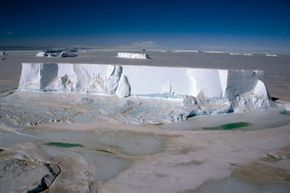Iceberg Statistics
There are six official size classifications for icebergs. The smallest ones are called growlers, and they're a little smaller than your car. The next larger size is a bergy bit (yes, that's the official classification), which can be about the size of a small house. The remaining four size categories are less colorful: small, medium, large and very large. Just how big is a very large iceberg? Technically, any iceberg more than 240 feet high and 670 feet long is in the "very large" category.
The true upper limit is amazing. An iceberg broke off of the Ross Ice Shelf in Antarctica in March 2000. Called Iceberg B-15, it was almost half a mile thick and its area was about 4,500 square miles -- roughly the size of Connecticut. It was the largest iceberg ever found by the U.S. National Ice Center since the center began tracking them about 25 years ago [source: Stone]. Considering that small time frame, we can assume that there must have been even more massive icebergs in the unrecorded past. Icebergs this large are sometimes referred to as ice islands. Arctic icebergs are generally smaller than Antarctic icebergs because the Arctic doesn't have the vast, uninterrupted spans of open ocean that Antarctica has. These expanses of ocean allow the formation of huge ice sheets.
Advertisement
Icebergs are also classified by shape. Tabular icebergs are flat sheets of floating ice. They're more common, and form at much larger sizes, in Antarctica. Non-tabular icebergs can take a variety of shapes, from tall spires to cube-like or completely irregular. The shapes change considerably as the iceberg melts. Sometimes they form arches or even canyons, with two separate "tips" connected underwater.
Although they form in far northern or southern areas, icebergs can float thousands of miles. An iceberg from the arctic floated as far south as Bermuda [source: Bryant]. The typical range for icebergs is much narrower. Antarctic icebergs are mostly trapped in the circumpolar current, never giving them a chance to float north. However, they have been known to interrupt shipping lanes between Australia, South America and South Africa [source: Bryant].
While any glacier can form icebergs, the vast majority of all northern icebergs calve from 20 or so glaciers in or near Greenland, mostly on the western side [source: International Ice Patrol]. The Labrador Current carries a small percentage of these bergs into the North Atlantic, where they can interfere with shipping. Arctic glaciers calve up to 15,000 icebergs annually, although an average of just under 500 ever float south of the 48th parallel [source: International Ice Patrol]. This number can fluctuate extensively, as iceberg formation is affected by distant weather patterns, climate conditions and long-term "calving cycles" that we don't fully understand [source: Bryant].
Ocean currents carry icebergs because most of the iceberg's mass is below water. In fact, icebergs often float into strong winds when the current is moving in the opposite direction.
